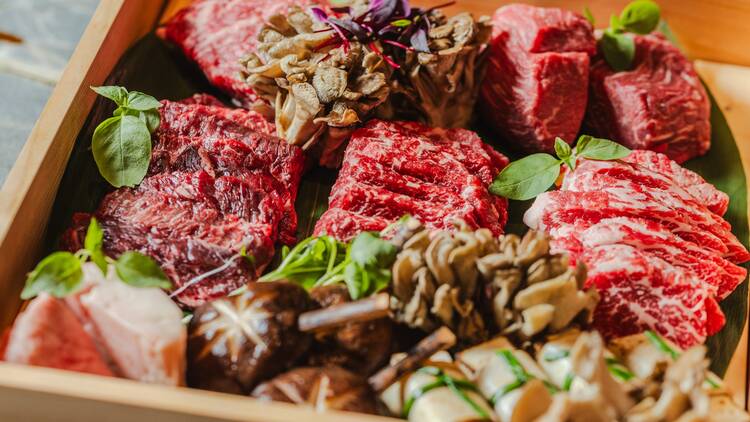In a recent article declaring “omakase the new steakhouse” for young, wealthy men looking to convene around exorbitant proteins, the New York Times deployed the term “bromakase,” which its critic, Pete Wells, apparently christened back in 2020. The word reverberated around in my head as I worked through the 10 distinct beef preparations (out of a hefty 14 courses) at Bonyeon, Chicago’s only beef omakase restaurant. After all, what’s bro-ier than a $300 red meat omakase in the steak-loving former epicenter of meatpacking? At times I pondered the concept’s appeal beyond the well-off beef brah. But clever, ebb-and-flow pacing and storytelling moments teasing Korea’s heritage of pairing beef with raw veg converged to create a nuanced experience unlike anything else in Chicago.
Like most major cities, omakase has catapulted into Chicago’s mainstream restaurant culture, manifesting in a slew of upmarket coursed sushi experiences and a few spinoffs on the concept featuring tacos (Cariño, Taqueria Chingón) and now beef. Bonyeon, the third restaurant in Korea natives Sangtae and Kate Park’s mini-empire (which also includes Michelin-starred Omakase Yume and the more casual Tengoku Aburiya), takes its cue from the high-end beef omakases popular in Seoul, Korea. The meal starts with a chef introducing various marbled cuts from various, well-cared-for cattle breeds in a pretty wood box. Then he slices and sears them in beef tallow on a downdraft grill before tweezing them onto your plate one by one. When I was there in late May, most of the meat came from Queensland, Australia and Ennis, Texas, with a single Japanese A5 wagyu cameo.
Even for tasting menus, Bonyeon’s is a pricey one; a prepaid ticket for one costs $306, which includes service but not tax or drinks. I coughed up another $70 for a pint-size bottle of Yangchon ChungJu Korean rice wine—savory and earthy in a mushroomy sense buoyed by gentle, rounded sweetness. It saw me through the entire meal as a ready companion to the various beef expressions, unsurprising seeing how it’s a traditional pairing in Korea, the server told me.
The opening bite of minced beef flank tartare seasoned with soy extract and micro fennel was quietly mineral beneath its ostentatious attire of gold leaf-dabbed beluga caviar. The salinity of the roe transitioned us to the remarkable pyeonyuk-chae that followed, a modern take on a Korean terrine that originated as a byproduct of broth-making for banquets. Boiled and cold-pressed beef slices were carved into matchstick noodles and submerged in a kelpy nori-cucumber sauce spiked with soy. The beef’s springy texture confoundingly mimicked that of a starch with a flavor like the pure comfort of braised brisket.
A dizzying succession of char-edged meats came next, separated by a bracing exclamation point of ramp kimchi or vinegared mushroom. Rare, seared tenderloin wedges flanked a section of bone marrow that had been ingeniously melted with caramelized onions and miso for dipping. Slabs of short rib arrived with applewood smoked salt for dabbing, then hanger steak with black sea salt. The latter distinguished itself by an almost bloody, beefy quality that I relish in this cut. But it mostly felt like I was eating a lot of (very good) beef without much to distinguish one fat-oozing morsel from the next.
I’d barely registered this realization, however, when my senses tingled again as the chef unfurled a piece of marinated galbi (a.k.a. short ribs cut across the bone) with a flourish like releasing a trick deck of cards. Cutting the beef in this honeycomb shape “shortens the muscle fibers and increases surface area,” he told us, allowing more sticky, fiery marinade to absorb into the marbled meat and supercharge caramelization. Dually plating the galbi unadorned and tucked in a lettuce wrap with ssamjang and miso trained our full attention on this beloved preparation. A subsequent interlude of ramp dongchimi (radish-wrapped ramp kimchi in radish sipping brine) arrived at just the right time, like a sensorial dip in a clear lake.
Generation upon generation of Koreans have eaten raw vegetables alongside their meals, both for the invigorating contrast to cooked, sauced meats and health benefits—evident in the ubiquity of banchan on every Korean table. My favorite interpretation of this materialized in back-to-back dishes honoring the humble onion: First as a heap of shaved white onions bobbing alongside caramelized outside skirt steak in soy jus (that chef Park has perfected over three decades); then as a nest of raw scallions balled atop savory-sweet tteokgalbi (marinated ribeye patty), which was formed around a beef bone and then cooked. The chefs instructed us to stuff as much of the alliums into each bite as we could contentedly take; their piquancy cut through the meat’s fatty, umami baritone like Mariah Carey’s whistle register.
The narrative tidbits you’ll glean throughout the meal may vary depending on who’s cooking. The taciturn chef tending to our end of the counter stuck to a meager script, so I’d strain to pick up details from his chattier counterpart: That mieyok-jook (congee with seaweed, paired here with meltingly tender braised sea bass) is traditionally eaten on one’s birthday; that the radish kimchi was in fact vegan; that the chefs snuck a bit of caramelized onion into the aforementioned marrow schmear.
Then again, whether you’re a beef bro, Koreaphile or simply curious what on earth to expect when signing on for 10 courses of steak, I think you’ll find that the beef at Bonyeon has plenty to say on its own.
Food: This pricey, generously portioned progression chops, slices, marinates, sears and simmers an array of premium beef cuts—often homaging traditional Korean preparations. A few well-placed intermissions jolt the protein-addled senses via fresh and pickled veg, fish congee and handmade Japanese soba noodles.
Drink: Optional standard ($155) and reserve ($200) wine pairings focus heavily on traditional styles from France and California. Consider a 375-mL bottle of Korean Sool (grain-based rice wine or soju, plum liqueur or barley soju), which run the gamut from fruity and floral to clean and boozy, nutty, savory and spicy.
Vibe: This minimalist 12-seater traffics in blues, golds, grays, blacks and gleaming workspaces with bright spotlighting to showcase the beef. Bonyeon hosts two seatings per night Wednesdays through Sundays, which run a nimble two hours. The restaurant also offers a nine-course option for $195 on Wednesdays.




